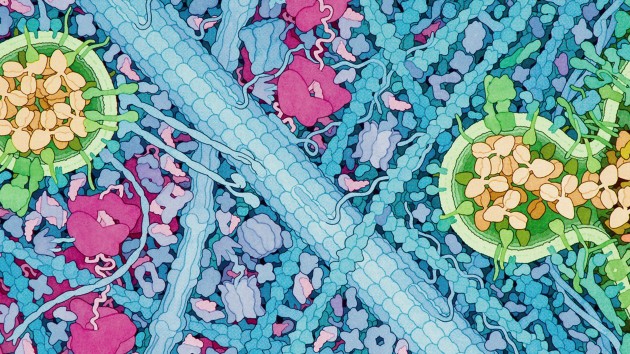Collections
Filters
-
Collection Type
-
-
Focus |
 Targeting Chromatin
Targeting Chromatin
This special Focus on Targeting Chromatin features Reviews, Perspectives and a Comment that discuss chromatin-associated proteins that are the subject of current drug-development efforts, highlighting chromatin processes as promising targets for therapeutic intervention.
Image: Erin Dewalt -
Focus |
 50 years of eukaryotic transcription
50 years of eukaryotic transcription
To mark the 50th anniversary of the discovery of the three nuclear RNA polymerases, we feature a collection of Perspective and Review pieces that narrate the history of eukaryotic transcription research from a personal perspective.
Image: Art by Erin Dewalt, inspired by the concept of “ever-expanding complexity”. -
Focus |
 Focus on Cycles and Rhythms
Focus on Cycles and Rhythms
Daily rhythms are an integral part of life. This special Focus on 'Cycles and Rhythms' features Reviews and a Perspective that explore the molecular mechanisms that drive oscillatory behaviour and that underlie the generation of metabolic and circadian dynamics.
Image: Credit: FrankRamspott/DigitalVision Vectors/Getty -
Focus |
 Focus on Membrane Proteins
Focus on Membrane Proteins
Membrane proteins are central to many physiological processes and are targeted by ~50% of marketed pharmaceutical drugs. Determining the structures of membrane proteins is essential for understanding their function and for drug design. This Focus highlights the latest breakthroughs in elucidating the structure and mechanisms of ABC transporters and neurotransmitter-gated ion channels; it also explores recent technical and methodological advances in X-ray crystallography, cryo-EM, NMR and computational approaches to investigate membrane proteins.
Image: Credit: Erin Dewalt / Springer Nature -
Focus |
Reviews Focus on Telomeres
The progressive shortening of telomeres with each cell division determines cellular replicative capacity and ultimately induces cellular senescence. This Focus brings to light the complex interactions of telomerase and shelterin components in telomere length maintenance, the role of DNA damage-response factors in telomere replication and processing, and the consequences of telomere dysfunction in human disease and cancer cell proliferation.
-
Focus |
Reviews Focus on Noncoding RNAs
Noncoding RNAs are remarkably versatile molecules that accomplish a wide range of biological functions. This Focus highlights the roles of noncoding RNAs in biological processes ranging from translation to cellular reprogramming and reviews recent insights into the molecular mechanisms of different RNA-interference pathways. It also explores the potential of noncoding RNAs in synthetic biology and discusses challenges in the annotation and functional characterization of lncRNAs.
-
Focus |
Reviews Focus on Ubiquitin
Ubiquitin and ubiquitin-like proteins are protein modifiers that play key roles in a variety of cellular processes. This Focus highlights the recent major breakthroughs in understanding how these modifications are regulated and targeted to protein substrates. Recent insights in the role of ubiquitin-like proteins in autophagy, DNA targeting and ER-associated degradation will also be covered. Produced with support from Takeda.
-
Focus |
Reviews Focus on Epigenetic Dynamics
The dynamic nature of functional information present in the genome, such as DNA methylation, histone modifications and chromatin organization, is only beginning to be uncovered, along with the relationship between epigenomic patterning and developmental decisions or disease. This Focus, which comprises six Reviews written by leaders in the field, explores emerging themes and functional implications of epigenetic dynamics. The Review articles are freely available online for 3 months thanks to support from Active Motif
-
Focus |
Reviews Focus on Translation Control
Translational control has become a major focus of attention and research activity in the field of gene expression, and it is intricately linked to other mechanisms of gene regulation. Translation can be modulated by a myriad of factors and control mechanisms that target either the initiation step or a post-initiation event. Protein synthesis is of course mediated by the ribosome, so structural, functional and mechanistic insights into the translation machinery will help our understanding of how translation can be controlled. The latest developments will be covered in four Reviews and one Perspective, written by leaders in the field.
-
Focus |
Web Focus on Prions and Amyloids
The infectious agent in mammalian prion diseases is the misfolded form of the prion protein (PrPSc), which forms amyloid aggregates and can template the conversion of the native conformation (PrPC), causing neuronal dysfunction and brain damage. Amyloid aggregates are also associated with other neurodegenerative conditions, but whether amyloid fibrils or oligomers are the toxic species remains unclear. The Web Focus on Prions and Amyloids highlights recent NSMB papers in these areas, and features a review by Diaz-Espinosa and Soto, who discuss recent progress and existing models for the structure of PrPSc. Image shows prion protein immunostaining, from Wikipedia (author Sbrandner).
-
Focus |
Web Focus on Chaperones and Chaperonins
The 2011 Albert Lasker Basic Medical Research Award honors F. Ulrich Hartl and Arthur L. Horwich, for their "discoveries concerning the cell's protein-folding machinery, exemplified by cage-like structures that convert newly made proteins into their biologically active forms." We celebrate the award by presenting a collection of recent papers on chaperones and chaperonins published in NSMB.

 PDB 50th Anniversary: celebrating the future of structural biology
PDB 50th Anniversary: celebrating the future of structural biology